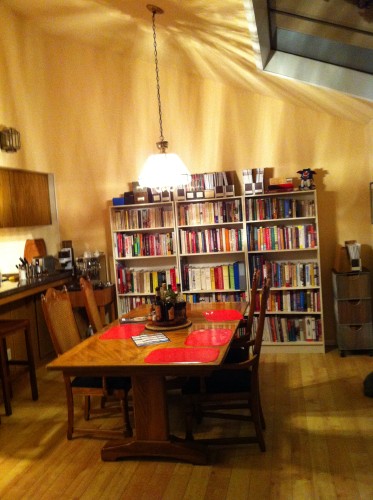I have over 500 cookbooks, folders full of recipe clippings and internet downloads, and index cards I’ve compiled over the years. Keeping track of what I’ve tried has been challenging. However, I’ve developed a three-pronged system that works for me. (I’ll discuss later how it works for Julian.)
- The recipe cards were relatively easy to track. I scrawled comments on the upper right-hand corner of the ones I tried and initiated a 1-to-4-star rating system. As the number of cards grew, I put the tested recipes into a separate box so I could find them easily.
- For the cookbooks, I started out with a loose-leaf notebook and kept notes on recipes I tested. Each cookbook is identified by a short code. For example, Joy of Cooking is joy, and the (original) New York Times Cookbook is NYT. Updated editions of these cookbooks have their own codes. There is a section of the notebook that identifies the cookbook and its code, and I pencil the code into the front of the cookbook.
- The clippings file started later. I also identified magazines by code (Bon Appétit is BA, for example) and kept track of them in a separate notebook and a multi-section file envelope. As the clippings expanded, I bought a rolling set of Pendaflex file boxes (see right of photo).
I digitized my files when I got my first Macintosh. I’ve used FileMaker Pro to create separate cookbook and clippings files. Typing in the code autofills the source of the recipe. I then add my comments. Recipes we’ve downloaded from the internet get classified as IN, and the cards are identified as card in the clippings file. At Julian’s request, I added a field for key ingredients that the recipe contains. That way I can find where my go-to recipe for fennel salad is by searching for fennel, pomegranate, and olives. Each cookbook record also contains the bookcase and shelf where it’s located. This comes in handy when I forget where I shelved a book I don’t use often. When I cull a cookbook (yes, it happens), I can easily delete the recipes I’ve tried from that book by searching on the code. I keep the loose-leaf notebooks as a backup for the digital files. (Yes, I back up my hard drive. Not as often as Julian would like…)
My most recent tweak to the system is to house the clippings I’ve tried in the notebooks where the ratings are. The recipes and ratings are by category (Appetizers, breads ,etc.), and the clippings are in plastic sleeves behind the ratings. This allows me easier access to clippings we use often, such as the aforementioned fennel salad.
This system, as I said earlier, works well for me. So how does it work for Julian? Most of the time, he asks me: “CJ, where’s that recipe for the crackling wings?” I hope that the above recent tweak helps him to find that recipe independent of me in advance of our next Super Bowl party. He does know in which cookbook some of our “best of” recipes reside, and sometimes he can find them without my help. I housed the barbecue and a few of his other favorite cookbooks at eye level right next to the coffee grinder and espresso machine (see left of photo) so he wouldn’t miss them. At some point we may replace those aging Ikea-esque bookcases with built-in bookshelves, but that may take a few years. Plus I’d have to revise the databases thereafter…

Recent Comments